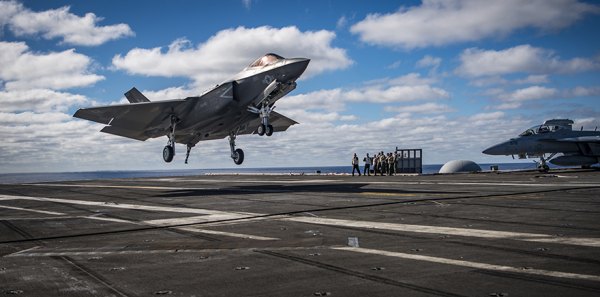
Lemoore Naval Air Station will be home to the Navy’s newest fighter jet, which eventually will replace the F/A-18E Super Hornet, which has been an important part of the Navy’s arsenal since the 1980s.
The key safe-for-flight operations certification is the final step for VFA-147’s transition from the F/A-18E Super Hornet to the F-35C Lightning II, the Navy’s latest fighter jet. The long certification process ensures that the typical Navy squadron is manned with qualified personnel to implement maintenance and safety programs in support of fleet operations. All transitioning squadrons are required to complete this certification prior to independently conducting flight operations.
When introducing a new aircraft to the Fleet, the appropriate fleet replacement squadron is assigned oversight responsibility for the transitioning unit. The VFA-125 “Rough Raiders” were re-activated in January of 2017 to fulfill the appropriate that important role for the incoming Lightning II. Since completing its combat deployment last winter, VFA-147 has been working with the Rough Raiders to accomplish the safe-for-flight operations certification. The Argonauts will be able to operate independently from the Rough Raiders, having received their safe-for-flight operations certification.
“Since we returned from deployment last December, our team has been driving toward fully bringing this platform online for the Navy," said VFA-147 Commanding Officer Cmdr. Patrick Corrigan. “As the Argonauts close out 2018 and the final stages of our safe-for-flight certification, we continue to exhibit the relentless drive required to meet transition goals and milestones. With this certification, we are announcing that we have the right skills, training, and people to take this mission and execute it, to its fullest potential.”
The safe-for-flight operations certification encompasses areas such as equipment, personnel, and programs. Not least among them is the requirement for the squadron to be in the physical custody of at least 30 percent of the assigned aircraft. Other requirements include the installation and operation of management information systems such as Autonomic Logistics Information Systems and its accompanying support networks. The Navy also requires operational F-35C squadrons to maintain robust, on-track, maintenance programs, as well as complete various inspections ranging from weapons to safety.
“The Argonauts’ safe-for-flight operations certification was earned through the herculean effort of squadron Sailors and is an acknowledgment that they have developed the skills to safely maintain and operate the F-35C Lightning II,” said Joint Strike Fighter Wing Commander, Capt. Max McCoy. “We eagerly look forward to declaring Initial Operating Capability (IOC) and integrating the F-35C into the Carrier Strike Group. This aircraft is a key component to maintaining the U.S. Navy’s dominance anywhere in the world.
“VFA-147 continues to accomplish significant milestones, advancing this program closer to its ultimate goal of integrating the F-35C into the Fleet,” said McCoy. “The exceptional performance of the squadron throughout the entire transition process is a testament to the hard-working Sailors who make the U.S. Navy F-35C program a reality. We will succeed because the professionals in this program will not let it fail. It is evident in all that they do. It is who we are as a team.”
The Navy’s Joint Strike Fighter Wing, headquartered at Naval Air Station Lemoore, California, ensures that each F-35C squadron is fully combat-ready to conduct carrier-based, all-weather, attack, fighter and support missions for the Navy. With its stealth technology, advanced sensors, weapons capacity, and range, the F-35C will be the first 5th generation aircraft operated from an aircraft carrier.
Currently, the U.S. Navy F-35C program is scheduled to declare initial operating capability by the end of February 2019.